Page 374 of 494
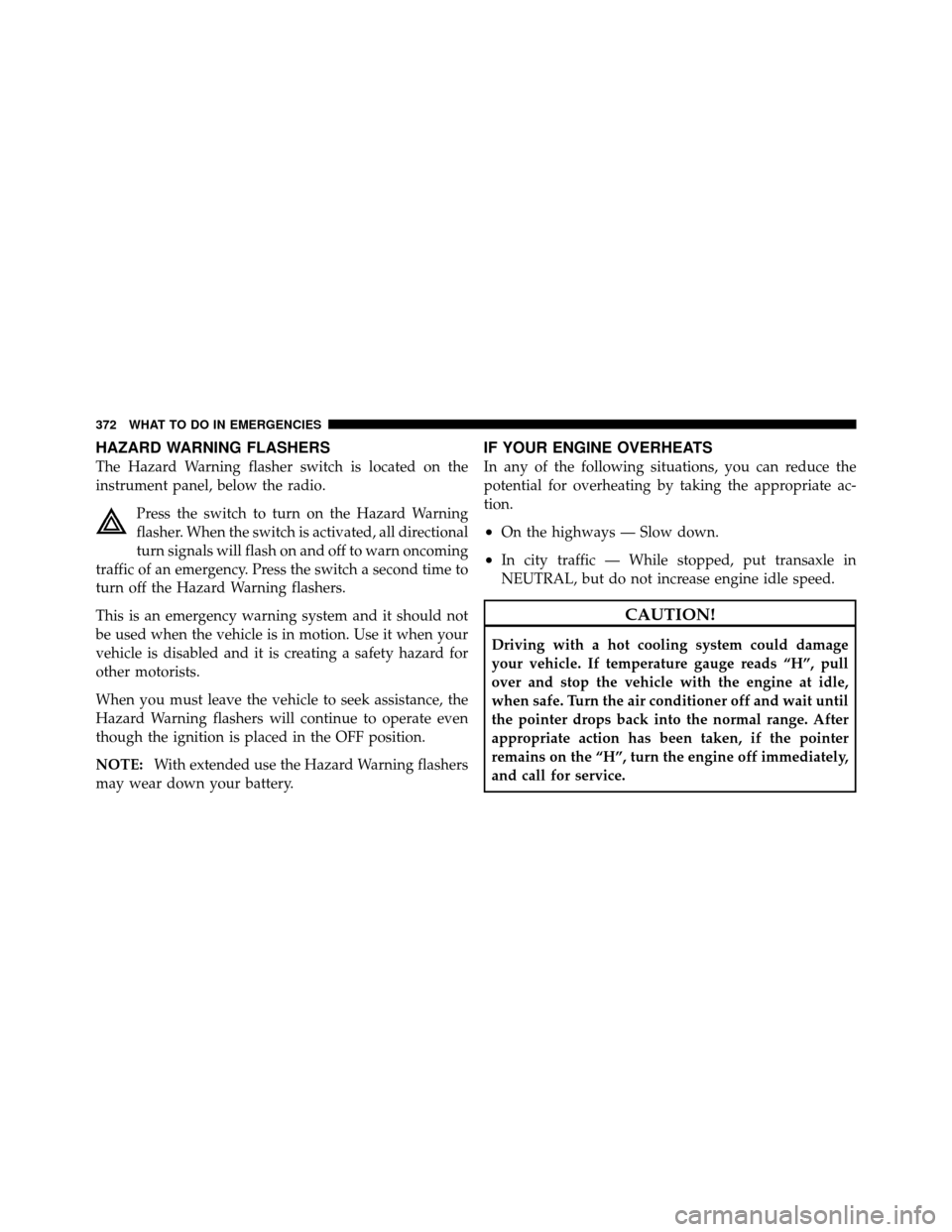
HAZARD WARNING FLASHERS
The Hazard Warning flasher switch is located on the
instrument panel, below the radio.Press the switch to turn on the Hazard Warning
flasher. When the switch is activated, all directional
turn signals will flash on and off to warn oncoming
traffic of an emergency. Press the switch a second time to
turn off the Hazard Warning flashers.
This is an emergency warning system and it should not
be used when the vehicle is in motion. Use it when your
vehicle is disabled and it is creating a safety hazard for
other motorists.
When you must leave the vehicle to seek assistance, the
Hazard Warning flashers will continue to operate even
though the ignition is placed in the OFF position.
NOTE: With extended use the Hazard Warning flashers
may wear down your battery.
IF YOUR ENGINE OVERHEATS
In any of the following situations, you can reduce the
potential for overheating by taking the appropriate ac-
tion.
•On the highways — Slow down.
•In city traffic — While stopped, put transaxle in
NEUTRAL, but do not increase engine idle speed.
CAUTION!
Driving with a hot cooling system could damage
your vehicle. If temperature gauge reads “H”, pull
over and stop the vehicle with the engine at idle,
when safe. Turn the air conditioner off and wait until
the pointer drops back into the normal range. After
appropriate action has been taken, if the pointer
remains on the “H”, turn the engine off immediately,
and call for service.
372 WHAT TO DO IN EMERGENCIES
Page 375 of 494
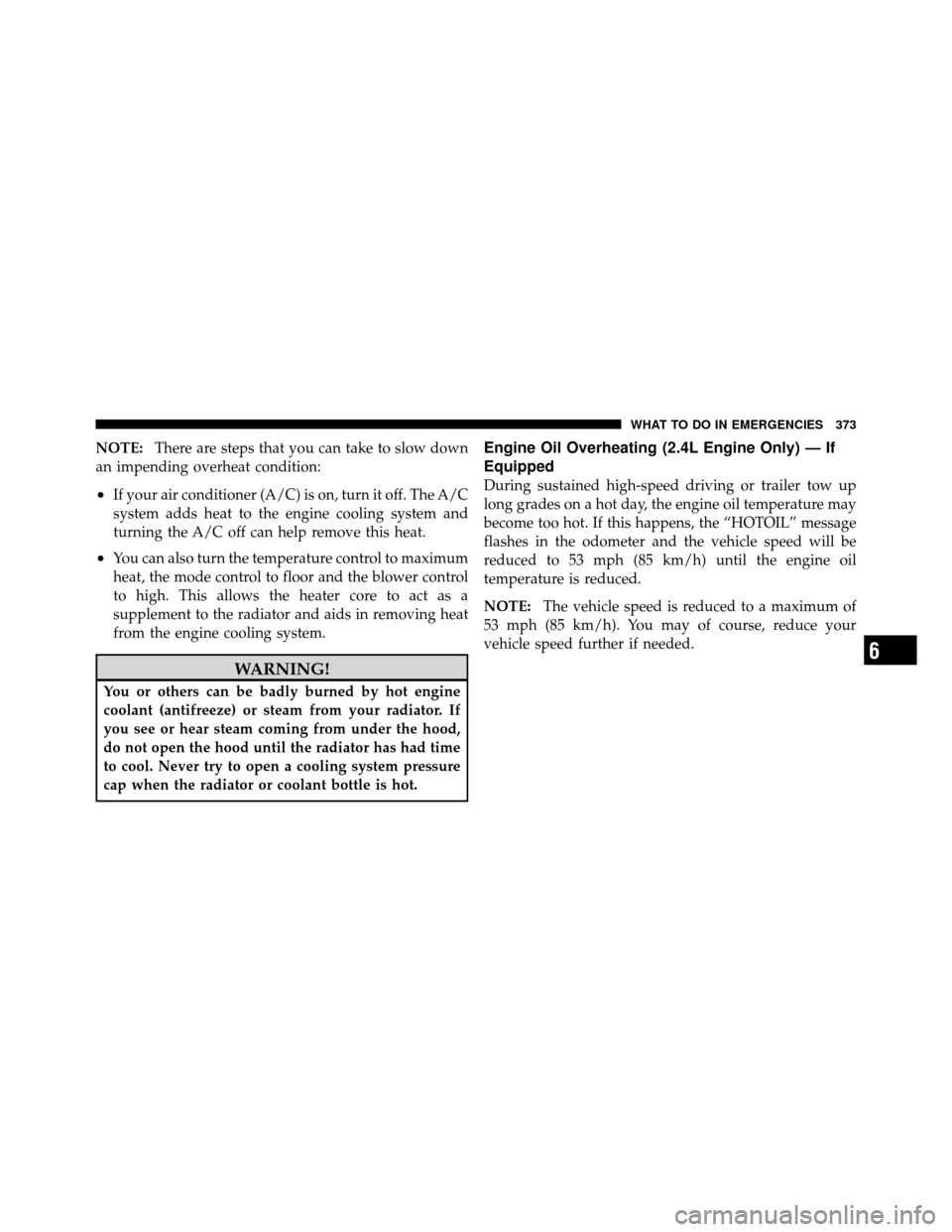
NOTE:There are steps that you can take to slow down
an impending overheat condition:
•If your air conditioner (A/C) is on, turn it off. The A/C
system adds heat to the engine cooling system and
turning the A/C off can help remove this heat.
•You can also turn the temperature control to maximum
heat, the mode control to floor and the blower control
to high. This allows the heater core to act as a
supplement to the radiator and aids in removing heat
from the engine cooling system.
WARNING!
You or others can be badly burned by hot engine
coolant (antifreeze) or steam from your radiator. If
you see or hear steam coming from under the hood,
do not open the hood until the radiator has had time
to cool. Never try to open a cooling system pressure
cap when the radiator or coolant bottle is hot.
Engine Oil Overheating (2.4L Engine Only) — If
Equipped
During sustained high-speed driving or trailer tow up
long grades on a hot day, the engine oil temperature may
become too hot. If this happens, the “HOTOIL” message
flashes in the odometer and the vehicle speed will be
reduced to 53 mph (85 km/h) until the engine oil
temperature is reduced.
NOTE: The vehicle speed is reduced to a maximum of
53 mph (85 km/h). You may of course, reduce your
vehicle speed further if needed.
6
WHAT TO DO IN EMERGENCIES 373
Page 391 of 494
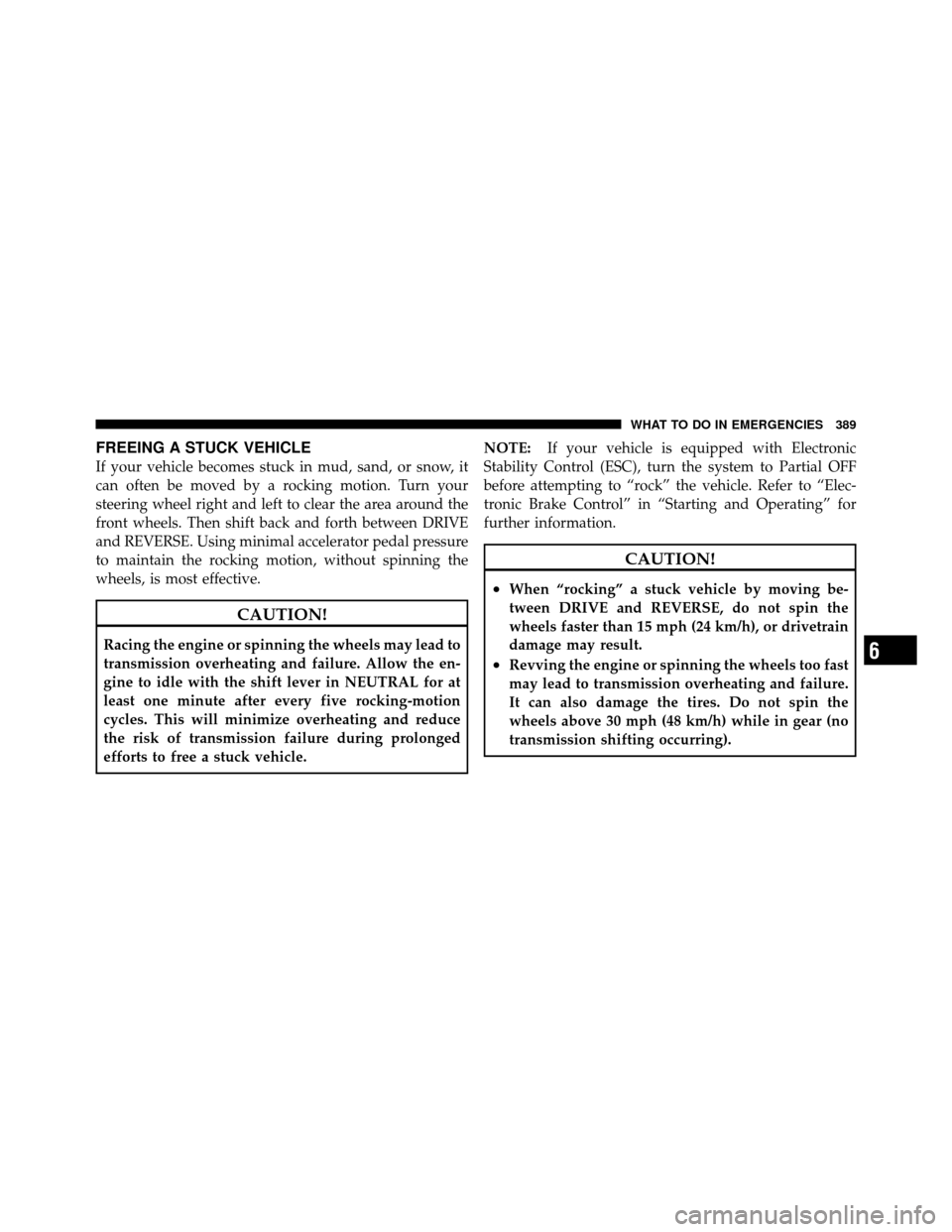
FREEING A STUCK VEHICLE
If your vehicle becomes stuck in mud, sand, or snow, it
can often be moved by a rocking motion. Turn your
steering wheel right and left to clear the area around the
front wheels. Then shift back and forth between DRIVE
and REVERSE. Using minimal accelerator pedal pressure
to maintain the rocking motion, without spinning the
wheels, is most effective.
CAUTION!
Racing the engine or spinning the wheels may lead to
transmission overheating and failure. Allow the en-
gine to idle with the shift lever in NEUTRAL for at
least one minute after every five rocking-motion
cycles. This will minimize overheating and reduce
the risk of transmission failure during prolonged
efforts to free a stuck vehicle.NOTE:
If your vehicle is equipped with Electronic
Stability Control (ESC), turn the system to Partial OFF
before attempting to “rock” the vehicle. Refer to “Elec-
tronic Brake Control” in “Starting and Operating” for
further information.
CAUTION!
•When “rocking” a stuck vehicle by moving be-
tween DRIVE and REVERSE, do not spin the
wheels faster than 15 mph (24 km/h), or drivetrain
damage may result.
•Revving the engine or spinning the wheels too fast
may lead to transmission overheating and failure.
It can also damage the tires. Do not spin the
wheels above 30 mph (48 km/h) while in gear (no
transmission shifting occurring).6
WHAT TO DO IN EMERGENCIES 389
Page 417 of 494

Under normal operating conditions, the catalytic con-
verter will not require maintenance. However, it is im-
portant to keep the engine properly tuned to assure
proper catalyst operation and prevent possible catalyst
damage.
NOTE:Intentional tampering with emissions control
systems can result in civil penalties being assessed
against you.
In unusual situations involving grossly malfunctioning
engine operation, a scorching odor may suggest severe
and abnormal catalyst overheating. If this occurs, stop
the vehicle, turn off the engine and allow it to cool.
Service, including a tune-up to manufacturer’s specifica-
tions, should be obtained immediately. To minimize the possibility of catalytic converter dam-
age:
•Do not shut off the engine or interrupt the ignition,
when the transmission is in gear and the vehicle is in
motion.
•Do not try to start the engine by pushing or towing the
vehicle.
•Do not idle the engine with any spark plug wires
disconnected or removed, such as when diagnostic
testing, or for prolonged periods during very rough
idle or malfunctioning operating conditions.
7
MAINTAINING YOUR VEHICLE 415
Page 479 of 494
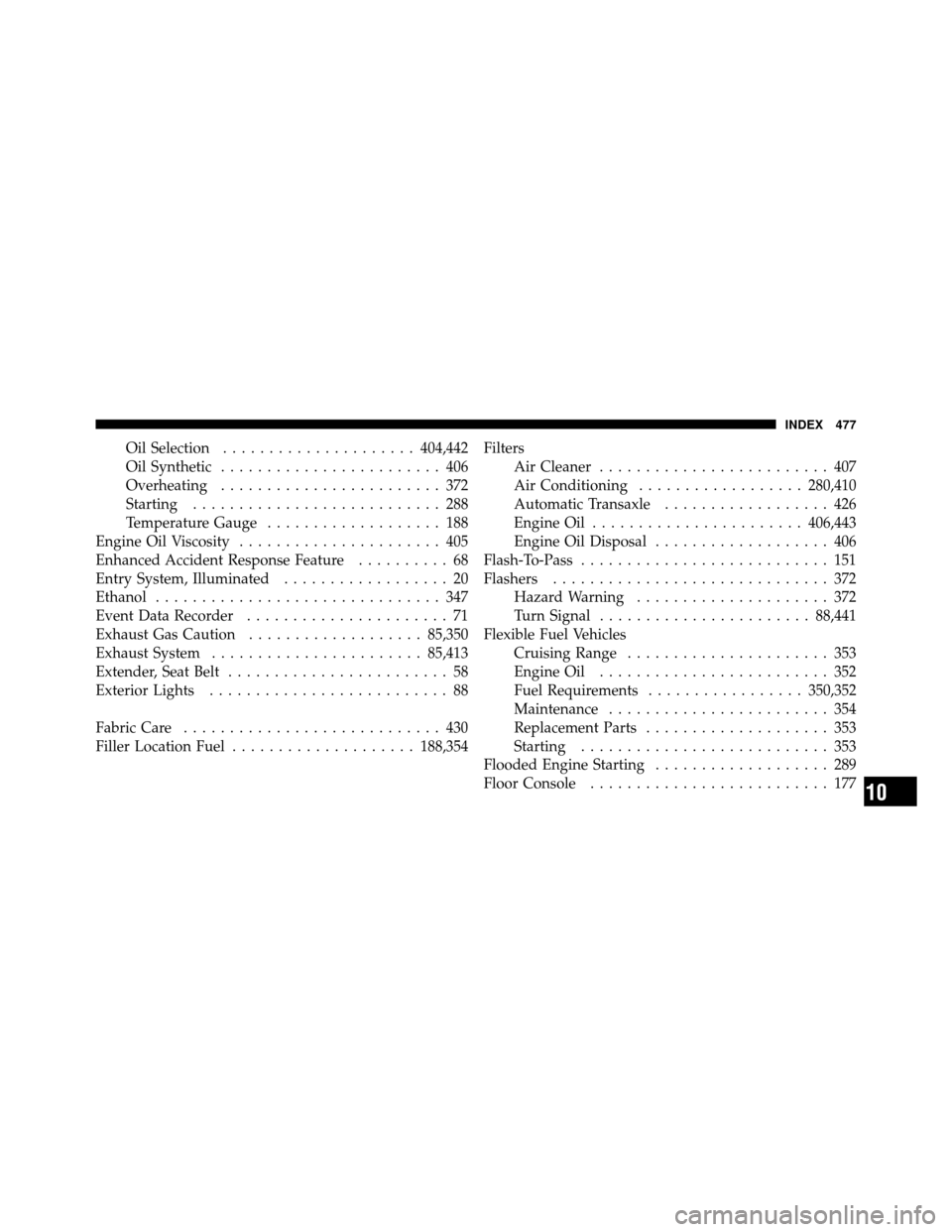
Oil Selection..................... 404,442
Oil Synthetic ........................ 406
Overheating ........................ 372
Starting ........................... 288
Temperature Gauge ................... 188
Engine Oil Viscosity ...................... 405
Enhanced Accident Response Feature .......... 68
Entry System, Illuminated .................. 20
Ethanol ............................... 347
Event Data Recorder ...................... 71
Exhaust Gas Caution ................... 85,350
Exhaust System ....................... 85,413
Extender, Seat Belt ........................ 58
Exterior Lights .......................... 88
Fabric Care ............................ 430
Filler Location Fuel .................... 188,354Filters
Air Cleaner ......................... 407
Air Conditioning .................. 280,410
Automatic Transaxle .................. 426
Engine Oil ....................... 406,443
Engine Oil Disposal ................... 406
Flash-To-Pass ........................... 151
Flashers .............................. 372
Hazard Warning ..................... 372
Turn Signal ....................... 88,441
Flexible Fuel Vehicles Cruising Range ...................... 353
Engine Oil ......................... 352
Fuel Requirements ................. 350,352
Maintenance ........................ 354
Replacement Parts .................... 353
Starting ........................... 353
Flooded Engine Starting ................... 289
Floor Console .......................... 177
10
INDEX 477
Page 485 of 494
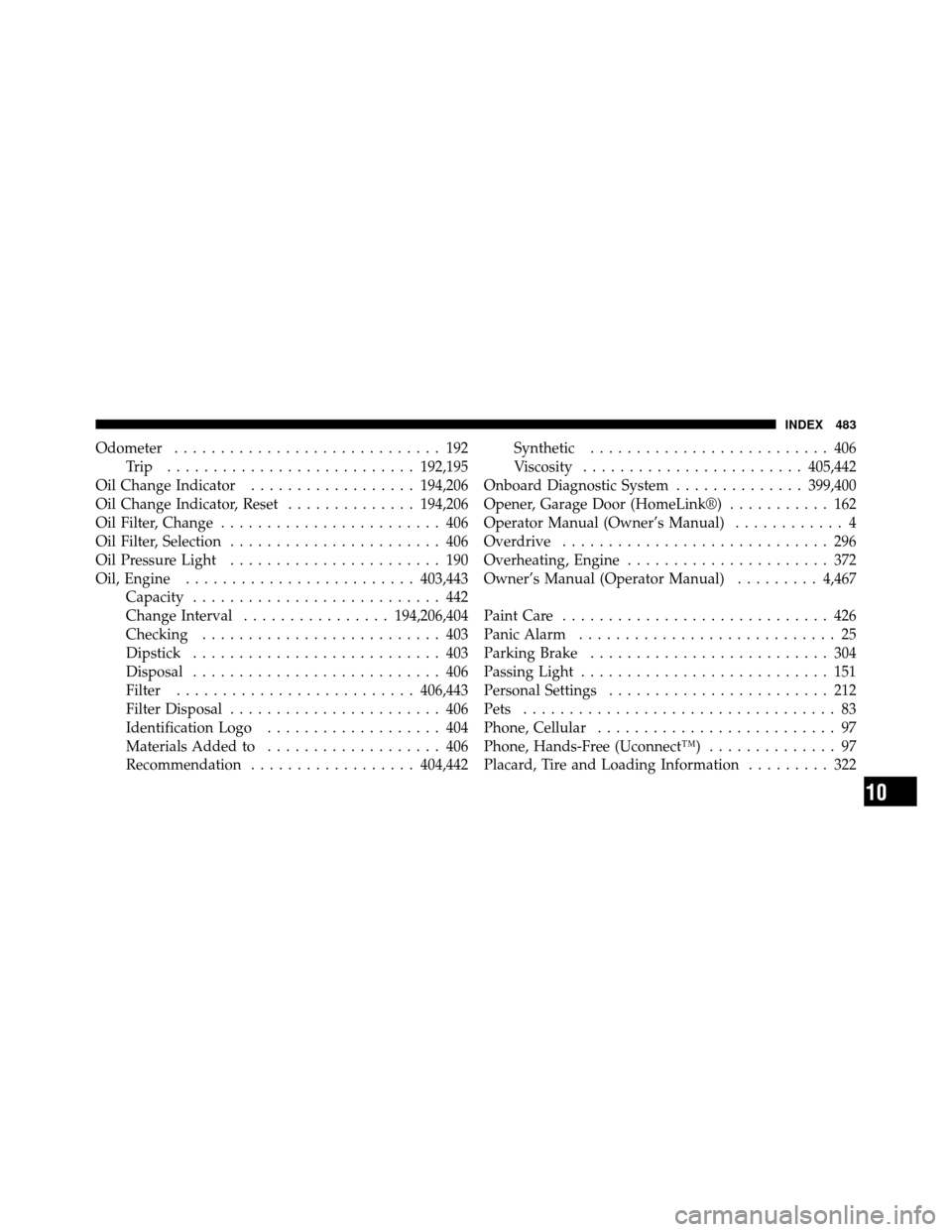
Odometer............................. 192
Trip ........................... 192,195
Oil Change Indicator .................. 194,206
Oil Change Indicator, Reset ..............194,206
Oil Filter, Change ........................ 406
Oil Filter, Selection ....................... 406
Oil Pressure Light ....................... 190
Oil, Engine ......................... 403,443
Capacity ........................... 442
Change Interval ................ 194,206,404
Checking .......................... 403
Dipstick ........................... 403
Disposal ........................... 406
Filter .......................... 406,443
Filter Disposal ....................... 406
Identification Logo ................... 404
Materials Added to ................... 406
Recommendation .................. 404,442Synthetic
.......................... 406
Viscosity ........................ 405,442
Onboard Diagnostic System ..............399,400
Opener, Garage Door (HomeLink®) ........... 162
Operator Manual (Owner’s Manual) ............ 4
Overdrive ............................. 296
Overheating, Engine ...................... 372
Owner’s Manual (Operator Manual) .........4,467
Paint Care ............................. 426
Panic Alarm ............................ 25
Parking Brake .......................... 304
Passing Light ........................... 151
Personal Settings ........................ 212
Pets .................................. 83
Phone, Cellular .......................... 97
Phone, Hands-Free (Uconnect™) .............. 97
Placard, Tire and Loading Information ......... 322
10
INDEX 483
Page:
< prev 1-8 9-16 17-24